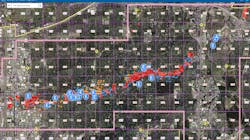Unlike the state's high school football season, which fans can set their watches to each year, Texas doesn't have an official tornado season. Since 1950, however, the National Weather Service has widely considered March through the beginning of June as the time when residents can expect heavy thunderstorms and destructive funnel clouds to tear through the state.
But that conventional wisdom could be changing. According to the National Oceanic and Atmospheric Administration, Texas only had 52 tornadoes in 2018, and the state's unofficial total is already at 188 for 2019. The tornadoes that hit the Dallas-Fort Worth area might be a look at the kind of sudden storms devastating communities late in the year.
At least 10 tornadoes ripped through the various parts of Dallas and the surrounding counties Oct. 20, with winds reaching 140 mph in some places, according to the NWS. The largest tornado measured by the weather service—an EF-3 on the intensity scale—touched down near Interstate-35E in North Dallas and Richardson.
Overall, those tornadoes damaged 905 buildings while destroying 106, according to the Dallas Fire-Rescue Department. The most staggering numbers, though? Only seven people were injured, and no fatalities were reported, the department said.
Such an extraordinary storm event required an extraordinary response. More than 400 firefighters, EMTs and other first responders from 13 different agencies around the area were deployed to deal with 187 emergency calls, according to the department.
But that avalanche of numbers doesn't describe what crews initially encountered when they first reached the scenes were tornadoes touched down. With a single tornado, firefighters might need to deal with a structure fire, high water rescues, medical calls or other emergencies.
"There was immense chaos due to extensive tornado damage," said Assistant Chief Justin Ball, who handles special operations and emergency response for the Dallas Fire-Rescue Department.
RESPONDING DEPARTMENTS AND AGENCIES:
- Dallas Fire-Rescue Department
- Plano Urban Search and Rescue/Hazmat
- Frisco USAR/Hazmat
- Wylie HAZMAT
- Grand Prairie Hazmat
- Lake Tawakoni
- Coppell
- Hurst
- Carrolton K9
- Northeast Fire Department Association USAR
- Grapevine
- Euless
- Haltom City
- Keller
- Carrolton
Two separate command posts were set up, with deputy chiefs in charge at each location. Crews first handled an "overwhelming number" of victims trapped by debris, and "Rescue problems were handled as efficiently as possible," Ball added.
Once those individuals were taken care of, primary search teams used map grids to systematically assess the damage done by the tornadoes—something that couldn't be determined immediately—and to make sure those areas were clear of any other emergencies.
Rescuers also needed to be cautious of downed power lines, gas leaks and multiple collapse zones. They also couldn't rely on electricity while working at scenes. At its peak, more than 150,000 customers were without power in the wake of the tornadoes, according to Oncor, which supplies electricity to the Dallas area.
"The power outages made searches and damage assessments very difficult to complete accurately and efficiently," Ball said. "The unknown factors regarding damage and the complete effect of the tornado created constant concerns for managing needs with the adequate resources with minimal intelligence or feedback."
BY THE NUMBERS:
- Storm-Related Calls: 187
- Injuries: 7
- Deaths: 0
- Buildings Damaged: 905
- Affected Buildings: 156
- Buildings Destroyed: 106
- Buildings with Major Damage: 287
- Buildings with Minor Damage: 356
Thermal imagers sometimes were used when work needed to be done at night or during outages. Trees and wreckage also were cut away "with little to no lighting as crews climbed over and under damaged and unstable structures to search," Ball said.
With so many first responders from multiple departments in the field—at times, without mutual aid requests or approval from their departments—coordinating all of those moving parts could have posed a problem. But because crews checked in as they cleared areas on their map grids, personnel was accounted for and apparatus was able to return to the staging area for refueling.
"The outcome of the operation turned out to be positive. … Excellent job by all companies," Ball said.
As much damage was done by last month's tornadoes, the storms themselves lasted only a brief amount of time. But Dallas Fire-Rescue personnel maintained an incident command for 10 days in the storm event's aftermath, helping with road clean up and touring scenes with local and state officials, according to the assistant chief.
Firefighters also learned that tornadoes don't discriminate between stations and civilian buildings. Two Dallas firehouses—Station 35 and Station 41—were hit in the Oct. 20 storm. Response times were unaffected, but apparatus and gear from those facilities needed to be moved to other locations.
"Station 41 is likely a total loss, but Station 35 just sustained damage to an outside perimeter wall," Ball said.
No injuries were reported at either firehouse, and firefighters took shelter in inside hallways.
"They have not admitted to being afraid, but I’m sure they were," he added.







